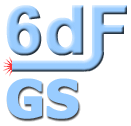|
* DR3 now active *
|
Description of the FITS files
As well as the parameterised data stored in the SQL database tables
each 6dFGS target object has a multi-extension FITS file
(named targetname.fits)
The first 5 extensions contain thumbnail images with built in WCS. The
optical B & R images come from SuperCOSMOS scans of blue and red
survey plates. The 2MASS J, H & K images were extracted from
datacubes supplied by IPAC. NB Although some objects in TARGET do not
have 2MASS images the corresponding extensions still
exist in the FITS file but contain small placeholder images . The remaining extensions contain the
spectra. Each 6dFGS observation will usually result in a further 3
extensions, the V
band spectrum, the R band spectrum and the combined/spliced VR
spectrum. If an object is observed more than once further spectral
extensions are added e.g. if an object is observed 3 times its
FITS file will hold the 5 image extensions and 9 spectral extensions.
In cases of orphan fields, which contain only one of either V or R,
the other extensions (R or V and VR) still exist but are just copies of
the single passband frames.
The V and R extensions are images with 3 rows. The 1st row is the
observed reduced SPECTRUM, the 2nd row is the associated variance
and the 3rd row stores the SKY spectrum as recorded for each data
frame. Wavelength information is provided in the header keywords:
CRVAL1, CDELT1, CRPIX1. In that
wavelength(Angstroms) = CRVAL1 - (CRPIX1 - pixel no) x CDELT1
The VR extension also has an additional 4th row that
represents the wavelength axis explicitly (as well as via WCS
keywords), which has a continuous
dispersion, achieved through the continuation of the V dispersion into
the R half from rescrunching.
Additional WCS keywords are also included to ensure the wavelength
information is displayed correctly when using image browsers such
as Starlink's GAIA or SAOimage DS9.
| 1st extension | header | SuperCOSMOS Bj thumbnail image, 1x1 arcmin |
| 2nd extension | header | SuperCOSMOS R thumbnail image, 1x1 arcmin |
| 3rd extension | header | 2MASS J thumbnail image, variable
size |
| 4th extension | header | 2MASS H thumbnail image, variable
size |
| 5th extension | header | 2MASS K thumbnail image, variable
size |
| 6th extension | header | eg V-spectrum extension |
| 7th extension | header | eg R-spectrum extension |
| 8th extension | header | eg combined/VR-spectrum extension |
| next ..... | | further spectral extensions if object observed again |
Home |
Intro |
Schema |
Access |
FITS files
WFAU, Institute for Astronomy,
Royal Observatory, Blackford Hill
Edinburgh, EH9 3HJ, UK
Tel +44 131 668 8356 (office)
or +44 131 668 8100 (switchboard)
6dfdata@aao.gov.au
26/8/2008
|


